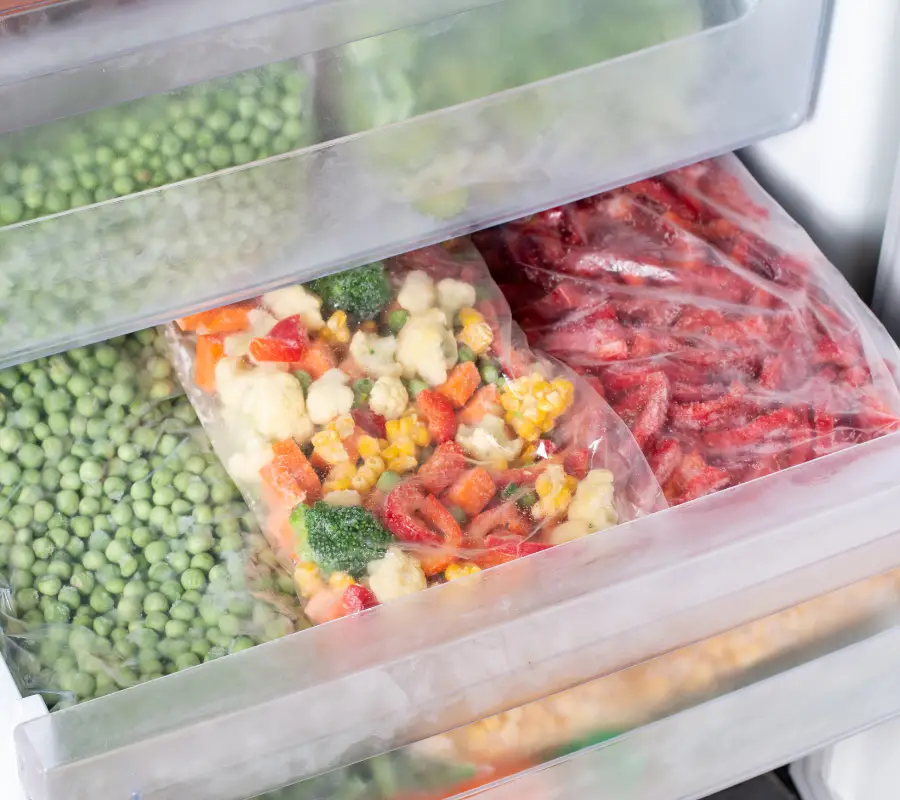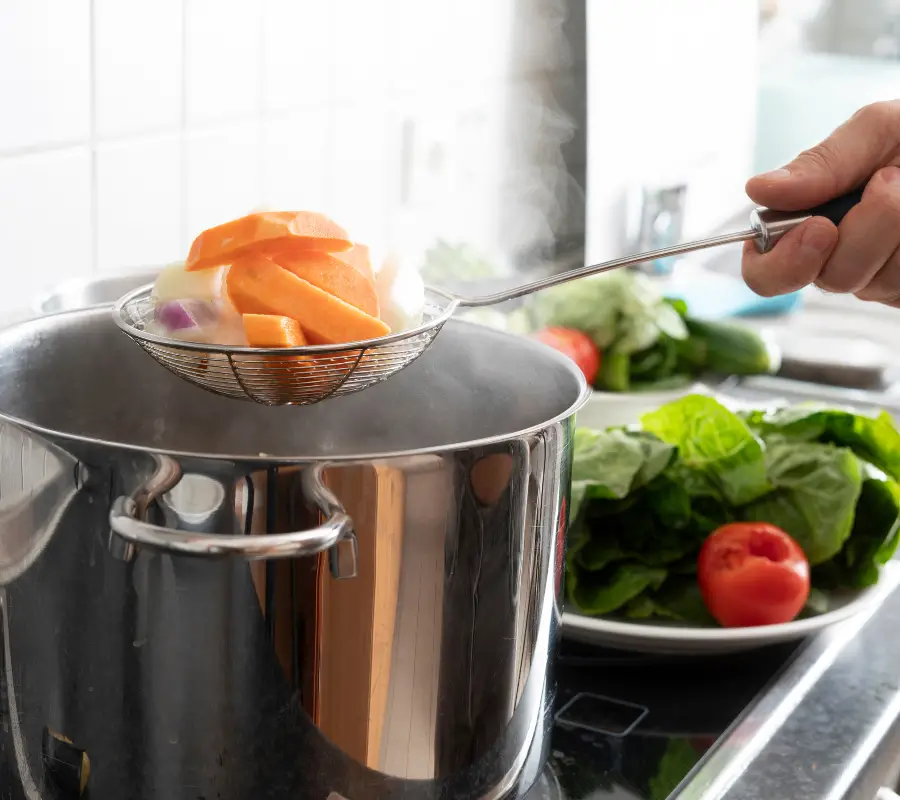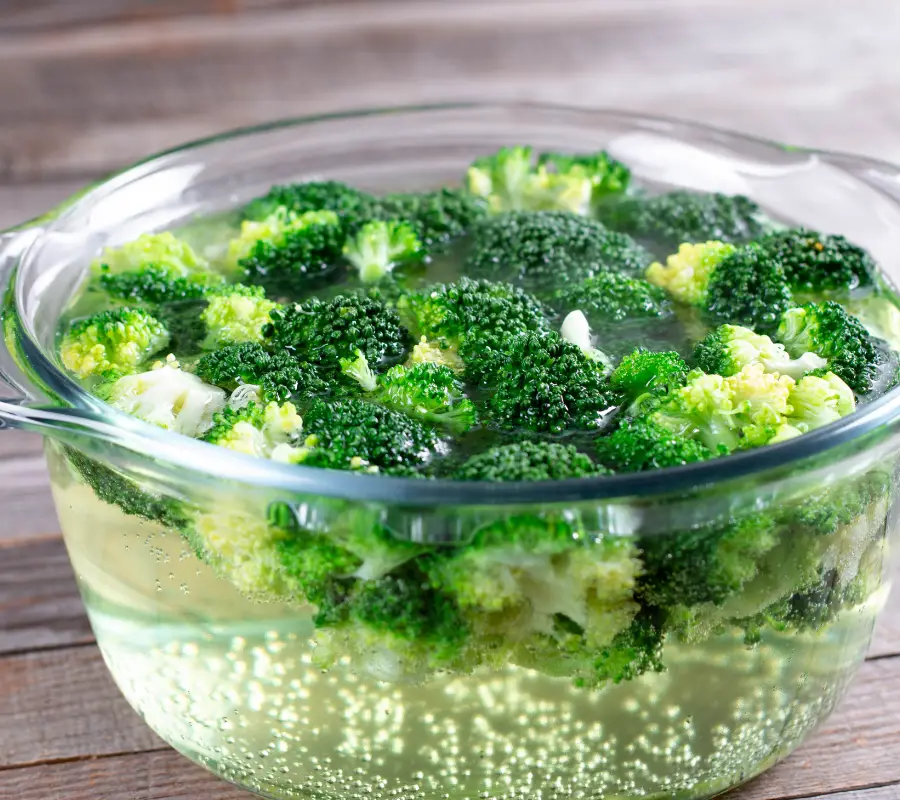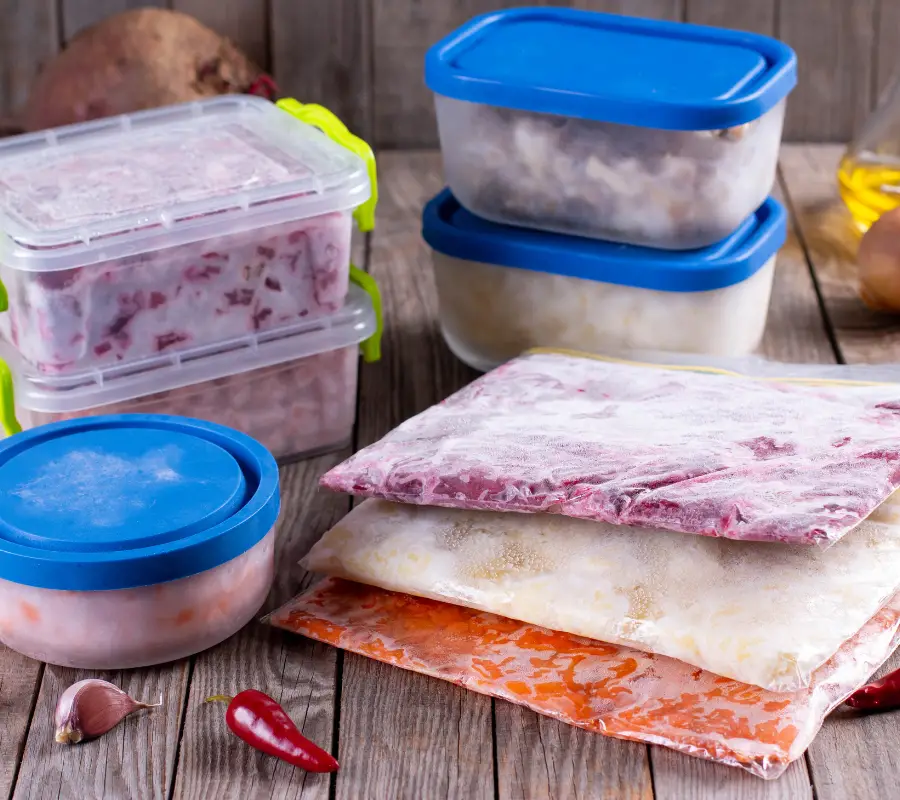How To Prepare Vegetables For Freezing
If you’re looking for a way to make nutritious and delicious meals throughout the year, freezing your own vegetables is an excellent choice! Whether you have your own garden or shop at the grocery store, prepping, blanching, and freezing veggies can help save time on future cooking projects while ensuring that your food will last longer.
This blog post will provide step-by-step instructions on how to prepare different types of vegetables for freezing so you can enjoy them all year round—without worrying about quality or flavour being compromised. Read on to learn exactly what it takes to maximize storage life when preserving produce through quick-freezing techniques!

Freezing vegetables
Vegetables are considered non-acidic food because they do not contain much acid in them. However, once they are picked from the farms or gardens, the deterioration process starts. This happens because vegetables are living organisms and continue their metabolic process even after they are harvested.
The enzymes present in vegetables start breaking down the cell walls, leading to changes in texture, flavour, and colour. Therefore, it is advised to consume freshly picked vegetables as soon as possible to get the maximum nutritional value from them. Additionally, storing vegetables properly in a cool, dry place can help slow down the deterioration process.
What equipment do I need to freeze vegetables?
You will need the following items:

How to blanch vegetables for freezing
Blanching vegetables is a great way to preserve their fresh flavour and nutrients for later use. The best types of vegetables to blanch and freeze are those that are sturdy, like green beans, broccoli, cauliflower, carrots, and peas.
To start the blanching process, you will need a few essential pieces of equipment and materials. These include a large pot of boiling water, a bowl of ice water, a slotted spoon, and a timer.
To begin, prep your vegetables by washing them thoroughly and trimming any stems or leaves. Next, bring a large pot of water to a rolling boil on the stove. Once the water has reached the right temperature, add the vegetables to the pot, making sure they are completely submerged. Set the timer and allow the vegetables to boil for the recommended amount of time, which varies depending on the vegetable type and size.
When the timer goes off, use a slotted spoon to remove the vegetables from the boiling water and immediately transfer them to the bowl of ice water. This stops the cooking process and helps the vegetables retain their bright colour and crisp texture. After a few minutes in the ice water, remove the vegetables and drain any excess water.
Parboiling vegetables for freezing
Once your vegetables are blanched, pat them dry with a clean towel and store them in an airtight container or freezer bag. Label the container with the date and type of vegetable, and store it in the freezer for up to 8 months.
Blanching vegetables has many benefits, including preserving the nutritional content and flavour of the vegetables. When defrosting and cooking, it’s essential to remember that blanched vegetables cook faster than fresh ones, so they require less time on the heat.
Additionally, adding salt or herbs while blanching can enhance the flavour of the vegetables once they are defrosted. With these tips and tricks, you can enjoy fresh-tasting vegetables all year round.

Vegetables for freezing guide
Are you looking to stock up on fresh vegetables and preserve them for later use? Freezing vegetables is an excellent way to do just that. However, not all vegetables are created equal when it comes to freezing.
To help you master the art of freezing vegetables, I’ve put together a comprehensive guide that covers everything from the best types of vegetables for freezing to the necessary equipment and top tips required for the process.
Whether you’re a seasoned home cook or a beginner, this guide will provide you with all the information you need to freeze vegetables effectively and efficiently.
| Vegetable | Preparation | Blanching Time | Packing | Notes |
|---|---|---|---|---|
| Asparagus | Wash, trim, blanch and tie in bundles | Thin stems 2 mins Thick stems 4 mins | Freezer bags | Buy at their cheapest – use trimming for soups |
| Artichokes (Globe) | Remove outer leaves, trim tops and wash well. Add lemon juice to blanching water, drain and cool. | 7-10 mins | Freezer bags | |
| Aubergines | Peel, cut into 1-inch slices, blanch, cool and pack in layers using baking paper | 4 mins | Freezer bags, foil trays | |
| Avocados | Better as a puree with seasoning and lemon juice added. | Plastic containers. | ||
| Beans (Broad) | Pod and blanch | 3 mins | Freezer bags | |
| Beans (French) | Top and tail, slice or leave whole | 3 mins | Freezer bags | Freeze whole unblanched, store 3 months only |
| Beans (Runner) | Trim, slice thickly | 2 mins | Freezer bags | |
| Beetroot | Use small ones, cook until tender, cool, peel or dice | Boil for 40-50 mins | Plastic containers | |
| Broccoli | Trim, wash in salted water, cut into sprigs, blanch, drain well | 3-5 mins depending on size | Freezer bags | |
| Brussels sprouts | Peel, trim and wash. Blanch, cool and drain. | 3-5 mins | Freezer bags | |
| Cabbage | Wash, shred finely or cut into wedges, blanch, drain well. | 2-4 mins | Freezer bags | Chinese cabbage – blanch shredded for 1.5 mins |
| Carrots | Trim, peel or scrub and wash, slice or dice. | 4 mins | Freezer bags | Freeze young carrots whole unblanched, store for 3 months only |
| Cauliflower | Trim into small florets, wash and blanch in salted water, and drain well. | 3 mins | Freezer bags | |
| Celery | Trim, scrub and cut into 1-inch lengths, blanch, cool, and drain. | 3 mins | Freezer bags or plastic containers | Use only for cooked dishes |
| Celeriac | Wash, peel, steam until almost tender | Plastic containers | ||
| Chestnuts | Wash, peel and blanch, or cook until tender and puree. | 1-2 mins | Plastic containers | Freeze some puree sweetened to use for mousses, souffles or sauces. |
| Chicory | Remove outer leaves, add lemon to blanching water, drain and pack. | 2 mins | Freezer bags | Use in cooked dished or white sauce. |
| Corn-on-the-cob | Trim off leaves and silks, wash, blanch, cool and dry. | 4-8 mins depending on size | Individually wrap in freezer paper then plastic containers. | Do not freeze late-season cobs, only the youngest, freshest ones. |
| Courgettes | Wash, trim into 1cm slices, blanch or saute in butter. | 1 min | Plastic containers | Can also be halved, blanched 2 minutes and stuffed. Freeze whole unblanched. Store 3 months only. |
| Fennel | Trim, wash, cut into 1/2 inch slices, blanch, drain, pack | 3 mins | Freezer bags | Not suitable to serve raw |
| Marrow | Use young ones, peel, cut into 1-inch slices and remove seeds, blanch. | 3 mins | Freezer bags | |
| Mushrooms | Use small button mushrooms, wash, saute in butter for 1 minute, or slice larger ones. | Plastic containers | Freeze small button mushrooms unblanched, store for 3 months only | |
| Onions | Peel and chop | 2 mins | Double freezer bags | Freeze chopped unblanched, store for 3 months only |
| Parsnips | Trim, peel, slice or dice, blanch, cool, drain. | 2 mins | Freezer bags | |
| Peas | Shell, blanch, cool | 1 min | Freezer bags | Freeze unblanched, store 3 months only |
| Peas (Mangetout) | Trim ends, blanch and cool | 2-3 mins | Freezer bags | Open freezing ensures free-flow packs |
| Peppers | Wash, remove stems, pps and pith, cut in halves or strips, blanch, drain and cool. | 3 mins | Plastic Containers | Freeze sliced unblanched. store 3 months only. |
| Potatoes | Prepare chips and part fry 2 minutes, cool. For new potatoes scrub, cook until tender. | Freezer bags | ||
| Spinach | Wash carefully, blanch, cool, drain well and pack. | 2 mins | Plastic containers | Wash and freeze in freeze bags, unblanched and tightly packed, store 3 months only. |
| Tomatoes | Skin, simmer for 5 minutes, rub through sieve, pack. | Plastic containers or liquid bags | Wipe, remove stem and freeze whole in freezer bags, store 3 months only. Suitable for grilling and frying only. | |
| Turnips | Trim, peel and dice, blanch, cool, drain | 3 mins | Freezer bags | |
| Herbs (method 1) | Wash and chop herbs, pack into ice-cube trays and cover with water, freeze, turn out, pack and freeze. | Ice-cube trays, freezer bags | Store for 12 months and use individual cubes in soups, stews, sauces etc | |
| Herbs (method 2) | Remove any woody stalks, wash and shake dry, lay flat on sheet of freezer paper, fold in and crimps edges together. Crumble frozen leaves to save chopping them. |
REMEMBER
Unblanched vegetables require the usual full cooking time, and although enzyme activity will not cause ff flavours to develop during their short stay in the freezer, you will lose one desirable side-effect of blanching. That is the reduction of the number of micro-organisms present so that spoilage is more likely if the defrosted vegetables are not cooked and used up immediately. Blanched vegetables pack down conveniently into less space and are almost fully cooked – two points in favour of blanching,

Cooking frozen vegetables
Cooking with frozen vegetables can be a game-changer in the kitchen, saving time and providing a quick solution for busy weeknights. The best way to cook frozen vegetables is to simply heat them through using your preferred cooking method. Boiling, steaming, and sautéing are all great options for cooking frozen vegetables straight from frozen, with boiling being the quickest and easiest method.
To boil
Add a little salt and very little water and cook covered for about half the usual cooking time.
To Saute
Use a frying pan with a lid, melt some butter, add partially thawed vegetables and toss over high heat for 1 minute. Cover and cook over lower heat until tender, seasoning to taste and stirring occasionally.
To complement the flavour of frozen vegetables, consider adding seasonings such as garlic, onion, herbs, or spices. A sprinkle of parmesan cheese or a drizzle of balsamic vinegar can also add a nice touch. As a general rule, avoid adding salt until the end of the cooking process to avoid drawing out excess water from the vegetables.
When it comes to presentation, aim to keep things simple to let the natural flavours of the vegetables shine through. Using colourful dishes and garnishes can add a pop of visual interest. Overall, cooking with frozen vegetables is a great way to save time and make healthy eating easy and accessible. With these tips and tricks, you can confidently use frozen vegetables in your cooking and enjoy flavorful and nutritious meals every day.



